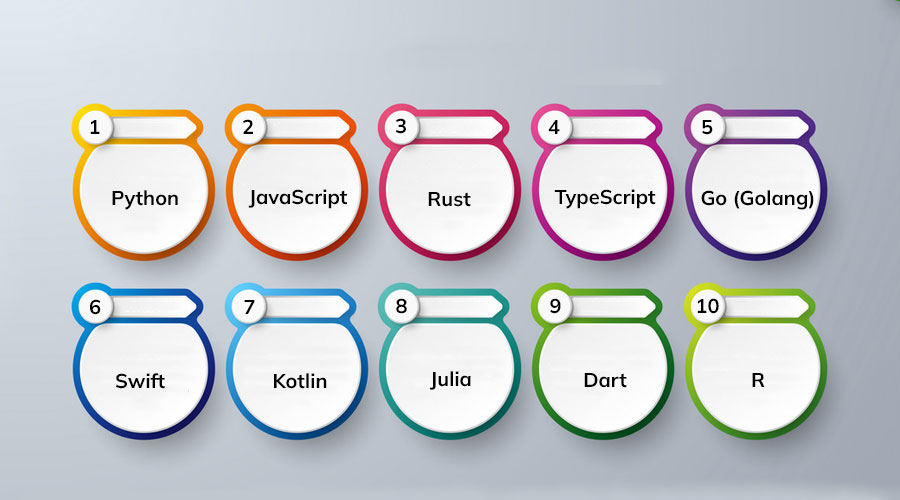Table of Contents
Top 10 Programming Languages of the Future
In the ever-evolving landscape of technology, programming languages play a pivotal role in shaping the future. As we venture into 2025 and beyond, the demand for innovative solutions continues to rise, driving the emergence of new programming languages while solidifying the position of established ones. Let’s delve into the top 10 programming languages that are poised to lead the way in the years to come.
- Python: Python’s versatility and simplicity make it a favorite among developers for various applications, including web development, data science, artificial intelligence, and automation. Its extensive libraries and ease of learning contribute to its widespread adoption and continued relevance in the future.
- JavaScript: As the backbone of web development, JavaScript remains indispensable in creating dynamic and interactive web experiences. With advancements in frameworks like React, Angular, and Vue.js, JavaScript continues to evolve, ensuring its prominence in the programming landscape.
- Rust: Rust’s emphasis on safety, performance, and concurrency positions it as a strong contender for systems programming, particularly in critical applications where reliability is paramount. Its growing community and support from tech giants indicate a promising future ahead.
- TypeScript: TypeScript, a superset of JavaScript, offers static typing and enhanced tooling capabilities, making it an attractive choice for large-scale applications. Its ability to catch errors early in the development process contributes to improved code quality and maintainability.
- Go: Developed by Google, Go shines in concurrent programming and scalability, making it ideal for building robust backend systems and microservices. Its simplicity, speed, and built-in support for concurrency ensure its relevance in the future of distributed computing.
- Swift: Apple’s Swift continues to gain traction, particularly in iOS and macOS app development. With its modern syntax, safety features, and performance optimizations, Swift is poised to play a significant role in shaping the future of mobile and desktop applications.
- Kotlin: Kotlin, endorsed by Google as an official language for Android development, offers seamless interoperability with Java along with modern language features. Its concise syntax and null-safety features enhance developer productivity and code reliability.
- R: R remains indispensable in the realm of data science and statistical computing, powering analytics and machine learning applications. With the increasing demand for data-driven insights, R’s robust ecosystem and statistical capabilities ensure its relevance in the future.
- Julia: Julia’s high-performance computing capabilities and ease of use make it a compelling choice for scientific computing and numerical analysis. Its growing ecosystem of packages and libraries positions it as a language to watch in domains requiring computational efficiency.
- Dart: Dart, backed by Google, is gaining momentum, particularly in cross-platform mobile app development with Flutter. Its reactive programming model and hot reload feature streamline the app development process, promising efficiency and productivity for developers.
How to Develop with Top 10 Programming Languages
In the ever-evolving landscape of technology, programming languages serve as the foundation upon which innovative solutions are built. As we inch closer to 2025 and beyond, the demand for proficient programmers versed in cutting-edge languages is on the rise. But which languages will dominate the future tech scene? Let’s delve into the top 10 programming languages poised to shape the future of coding:
- Python: Widely acclaimed for its simplicity and versatility, Python continues to soar in popularity. Its user-friendly syntax makes it ideal for beginners, while its robust libraries and frameworks cater to a myriad of applications from web development to data science and artificial intelligence.
- JavaScript: Powering the interactive elements of the web, JavaScript remains indispensable. With the advent of frameworks like React and Angular, JavaScript is not only vital for front-end development but also increasingly relevant for server-side applications with Node.js.
- TypeScript: A superset of JavaScript, TypeScript offers static typing, making codebases more maintainable and scalable. Its adoption is steadily rising, especially in large-scale projects where type safety is crucial.
- Rust: Recognized for its unparalleled performance and memory safety, Rust is gaining traction for systems programming, game development, and building robust, secure software where reliability is paramount.
- Golang (Go): Engineered by Google, Go is renowned for its simplicity, concurrency support, and fast compilation times. Its efficiency in handling microservices and cloud-native applications positions it as a top contender for future backend development.
- Swift: Apple’s Swift has emerged as the go-to language for iOS and macOS app development. With its concise syntax and modern features, Swift facilitates rapid prototyping and enhances developer productivity.
- Kotlin: Endorsed by Google as the preferred language for Android app development, Kotlin offers seamless interoperability with Java, along with concise syntax and enhanced safety features, making it a preferred choice for modern mobile development.
- R: As the go-to language for statistical computing and data analysis, R continues to be indispensable in fields such as data science, machine learning, and bioinformatics, where complex statistical models are prevalent.
- Julia: Designed for high-performance numerical computing, Julia combines the ease of use of dynamic scripting languages with the speed of compiled languages. Its ability to handle complex mathematical operations positions it as a frontrunner for scientific computing and AI research.
- Dart: Developed by Google, Dart is the language behind Flutter, a popular framework for building cross-platform mobile applications. With its reactive programming model and hot reload feature, Dart simplifies the development of visually appealing and responsive apps.
Why Should You Go for Top 10 Programming Languages of the Future
In today’s fast-paced digital landscape, the importance of programming languages cannot be overstated. They serve as the foundation for building software, applications, and technological innovations that shape our world. As we look towards the future, it’s essential to stay ahead of the curve by mastering the top programming languages that will drive innovation in 2025 and beyond.
- Stay Relevant in the Job Market: The tech industry is constantly evolving, with new technologies emerging at a rapid pace. By mastering the top programming languages of the future, you ensure that your skill set remains relevant and in-demand in the job market. Employers are always on the lookout for professionals who are proficient in cutting-edge technologies, giving you a competitive edge in your career.
- Unlock Exciting Career Opportunities: As technology continues to advance, new career opportunities are created in fields such as artificial intelligence, machine learning, data science, and cybersecurity. These domains rely heavily on specific programming languages like Python, R, and Java. By learning these languages, you open the door to lucrative career paths with ample growth potential.
- Adaptability and Flexibility: The top programming languages of the future are designed to be versatile and adaptable to various projects and industries. Whether you’re interested in developing mobile apps, creating web applications, or working in the realm of IoT (Internet of Things), mastering these languages equips you with the flexibility to tackle diverse challenges and projects with ease.
- Innovation and Creativity: Programming languages serve as tools for bringing creative ideas to life. By familiarizing yourself with the top languages of the future, you empower yourself to innovate and create groundbreaking solutions to real-world problems. Whether you’re passionate about developing sustainable technologies, revolutionizing healthcare, or enhancing user experiences, proficiency in these languages enables you to turn your visions into reality.
- Community and Support: The top programming languages often boast thriving communities of developers, enthusiasts, and experts who actively contribute to their growth and development. By becoming part of these communities, you gain access to valuable resources, forums, and networks where you can learn, collaborate, and seek guidance from seasoned professionals. This support system can significantly accelerate your learning journey and enhance your skill set.
- Future-Proof Your Career: Technology is continuously evolving, and so are the demands of the job market. By investing your time and effort in mastering the top programming languages of the future, you future-proof your career against obsolescence and ensure that you remain valuable and sought-after in an ever-changing industry landscape.
- Contribute to Global Innovation: The top programming languages of the future play a pivotal role in driving global innovation and progress. Whether it’s developing sustainable energy solutions, combating climate change, or advancing space exploration, technology serves as a catalyst for positive change on a global scale. By mastering these languages, you position yourself as a key player in shaping the future of humanity.
Market Prospects of Top 10 Programming Languages of the Future
In the dynamic landscape of technology, the choice of programming languages shapes the future of software development. As we stride into 2025 and beyond, the demand for proficient programmers in emerging languages is poised to surge. Let’s delve into the market prospects of the top 10 programming languages anticipated to dominate the tech realm in the coming years, exploring their applications and platforms.
- Python: Renowned for its versatility and simplicity, Python continues to lead the pack. With extensive libraries and frameworks, Python finds applications in web development, data analysis, artificial intelligence, and machine learning. Platforms like Django and Flask empower developers to create robust web applications and services swiftly.
- JavaScript: As the backbone of web development, JavaScript maintains its stronghold. With the rise of frameworks like React, Angular, and Vue.js, JavaScript facilitates the creation of interactive and responsive web applications. Moreover, the advent of Node.js extends its application to server-side programming, enabling full-stack development.
- Java: Despite being a mature language, Java remains indispensable in enterprise-level applications, Android app development, and large-scale systems. Its platform independence and robustness make it a preferred choice for mission-critical projects. Java frameworks like Spring and Hibernate enhance its productivity and scalability.
- TypeScript: A superset of JavaScript, TypeScript offers static typing and enhanced tooling support, mitigating errors and improving code maintainability. Its adoption is on the rise, particularly in large-scale projects and enterprise applications. With frameworks like Angular embracing TypeScript, its market prospects are promising.
- Go (Golang): Developed by Google, Go is gaining traction due to its simplicity, concurrency support, and efficient performance. It finds applications in cloud computing, microservices architecture, and scalable systems. Platforms like Kubernetes leverage Go for orchestrating containerized applications, fueling its demand in the DevOps landscape.
- Swift: Apple’s Swift is the go-to language for iOS and macOS app development, offering safety, speed, and modern syntax. With Apple’s ecosystem expanding, Swift’s market prospects are bright. Its compatibility with Objective-C and robust frameworks like SwiftUI and Combine further bolster its appeal to developers.
- Rust: Recognized for its safety, speed, and concurrency, Rust is gaining momentum in systems programming, game development, and performance-critical applications. Its memory safety features make it ideal for building secure and reliable software. Platforms like WebAssembly leverage Rust for high-performance web applications.
- Kotlin: Endorsed by Google for Android development, Kotlin offers modern features, seamless interoperability with Java, and enhanced productivity. Its concise syntax and null safety features mitigate common pitfalls in Android app development. With Android Studio officially supporting Kotlin, its market share is set to rise.
- R: As the lingua franca of data science and statistical computing, R remains indispensable in analytics, data visualization, and machine learning. Its extensive ecosystem of packages and libraries makes it a preferred choice for statisticians and data scientists. Platforms like RStudio provide an integrated development environment for R programming.
- C#: Backed by Microsoft, C# is prominent in game development, enterprise applications, and Windows desktop software. With the advent of .NET Core and Xamarin, C# extends its reach to cross-platform development and mobile app development. Its integration with Unity makes it a powerhouse in the gaming industry.
Essential Features of Top 10 Programming Languages of the Future
In the ever-evolving landscape of technology, programming languages serve as the foundation upon which innovation thrives. As we propel towards 2025 and beyond, the significance of selecting the right programming language cannot be overstated. To navigate the future successfully, it’s imperative to understand the essential features of the top 10 programming languages that will shape tomorrow’s digital realm.
- Adaptability and Flexibility: The programming languages of the future must exhibit adaptability to cater to the diverse needs of emerging technologies. They should seamlessly integrate with various platforms and frameworks, allowing developers to pivot swiftly as new challenges arise.
- Scalability: With the exponential growth of data and interconnected systems, scalability becomes paramount. Future programming languages must empower developers to build applications that can scale effortlessly, ensuring optimal performance regardless of the workload.
- Concurrency and Parallelism: As hardware capabilities advance, programming languages need to embrace concurrency and parallelism effectively. By enabling tasks to run concurrently and utilize multiple cores efficiently, languages can harness the full potential of modern computing architectures.
- Security: In an era plagued by cybersecurity threats, programming languages must prioritize security features. Robust mechanisms for data encryption, authentication, and secure coding practices should be inherent to prevent vulnerabilities and safeguard sensitive information.
- Community Support and Documentation: A vibrant and supportive community is indispensable for the growth and sustainability of a programming language. Extensive documentation, tutorials, and active forums foster collaboration, knowledge-sharing, and continuous improvement within the developer community.
- Machine Learning and AI Integration: With the proliferation of artificial intelligence and machine learning applications, programming languages must offer native support for these technologies. Integration of libraries, frameworks, and tools for data analysis and model deployment simplifies the development of AI-driven solutions.
- Cross-Platform Compatibility: As the digital ecosystem diversifies across devices and operating systems, cross-platform compatibility becomes a necessity. Programming languages that enable developers to write code once and deploy it seamlessly across multiple platforms enhance efficiency and reach.
- Performance Optimization: In the pursuit of efficiency, future programming languages must provide mechanisms for performance optimization. Whether through compiler optimizations, language features for low-level programming, or efficient memory management, performance-centric design is indispensable.
- Ecosystem and Tooling: A robust ecosystem of libraries, frameworks, and development tools accelerates the software development lifecycle. Programming languages that foster an extensive and well-maintained ecosystem empower developers to build complex applications with ease.
- Future-Proofing and Innovation: Lastly, the top programming languages of the future must exhibit a forward-thinking approach towards innovation. They should embrace emerging paradigms, language constructs, and development methodologies to stay relevant in a rapidly evolving technological landscape.
Advanced Features Top 10 Programming Languages of the Future
In the ever-evolving landscape of technology, programming languages play a pivotal role in shaping the future of software development. As we look ahead to 2025 and beyond, it’s crucial to identify the programming languages that are poised to lead the way with their advanced features and capabilities. Here, we delve into the top 10 programming languages that are expected to dominate the tech scene in the coming years, exploring their innovative features and potential applications.
- Python: Python has firmly established itself as a versatile and powerful programming language, thanks to its simplicity and readability. In the future, Python is expected to further expand its capabilities in areas such as artificial intelligence (AI), machine learning (ML), and data science. With advanced libraries like TensorFlow and PyTorch, Python will continue to drive innovation in these fields.
- JavaScript: JavaScript remains indispensable for web development, and its importance will only grow in the future. With the advent of frameworks like React and Angular, JavaScript enables the development of highly interactive and dynamic web applications. Additionally, its versatility extends to server-side development with Node.js, making it a top choice for full-stack development.
- Rust: Known for its focus on safety and performance, Rust is gaining traction as a systems programming language for building fast and reliable software. With features like fearless concurrency and memory safety, Rust is well-suited for developing high-performance applications, particularly in domains such as gaming, IoT, and systems programming.
- Golang (Go): Developed by Google, Go combines the efficiency of a statically typed language with the simplicity of syntax similar to scripting languages. Its built-in support for concurrency with goroutines makes it ideal for developing scalable and concurrent applications, particularly in distributed systems and cloud computing.
- Swift: Apple’s Swift has emerged as the preferred language for iOS and macOS development, offering modern features like type inference, optionals, and protocol-oriented programming. With its growing ecosystem and performance improvements, Swift is poised to lead the way in mobile app development, augmented reality (AR), and wearable technology.
- Kotlin: Kotlin, endorsed by Google as an official language for Android development, offers seamless interoperability with Java and exceptional tooling support. With features like null safety and coroutines, Kotlin enables developers to write concise and safer code, making it a compelling choice for building Android apps and backend services.
- TypeScript: TypeScript, a superset of JavaScript, brings static typing and advanced tooling to JavaScript development, enhancing code maintainability and scalability. As more developers adopt TypeScript for large-scale projects, its popularity is expected to soar, particularly in enterprise applications and complex frontend development.
- Julia: Julia has gained attention for its high-performance capabilities in scientific computing and numerical analysis. With its syntax resembling mathematical notation and built-in support for parallelism, Julia is well-suited for tasks such as machine learning, computational biology, and financial modeling, making it a promising language for the future of scientific computing.
- Dart: Dart, developed by Google, is primarily known as the programming language for building Flutter applications, offering hot reload, rich UI components, and native performance. As Flutter gains momentum in cross-platform app development, Dart is poised to become increasingly relevant in creating immersive and responsive user experiences across multiple platforms.
- Elixir: Elixir, built on the Erlang virtual machine (BEAM), excels in building scalable and fault-tolerant distributed systems. With features like lightweight processes and supervision trees, Elixir is well-suited for developing real-time applications, IoT devices, and distributed messaging platforms, making it a language to watch in the realm of concurrency and distributed computing.
How Much Does It Cost to Build with Top 10 Programming Languages of the Future
In the ever-evolving landscape of technology, programming languages play a pivotal role in shaping the future of software development. As we set our sights on the horizon of 2025 and beyond, it’s crucial to delve into the costs associated with building and nurturing the top programming languages poised to dominate the industry. Let’s embark on a journey to explore the financial implications of crafting the languages that will define the technological landscape of tomorrow.
- Research and Development Costs: Behind every successful programming language lies extensive research and development efforts. Teams of skilled developers, linguists, and computer scientists collaborate to design and refine languages that meet the evolving needs of the industry. These endeavors encompass ideation, prototyping, testing, and iteration cycles, all of which require significant financial investment.
- Talent Acquisition and Retention: Building a top programming language demands a proficient team of experts capable of pushing the boundaries of innovation. Recruiting top-tier talent comes with its price tag, as competitive salaries and benefits are essential for attracting and retaining skilled professionals. Moreover, ongoing training and skill development initiatives are necessary to keep the team abreast of emerging technologies and industry trends.
- Infrastructure and Tools: Creating a robust programming language ecosystem necessitates the development of supporting infrastructure and tools. This includes compilers, interpreters, debuggers, libraries, frameworks, and integrated development environments (IDEs). Investing in the creation and maintenance of these tools is crucial for facilitating the adoption and usage of the language among developers.
- Community Engagement and Support: Cultivating a vibrant and engaged community around a programming language is essential for its long-term success. Building forums, hosting events, providing documentation, and offering technical support are integral aspects of fostering a thriving ecosystem. Allocating resources towards community management and support initiatives is fundamental for nurturing adoption and driving innovation within the community.
- Marketing and Promotion: In an increasingly crowded market, effective marketing and promotion strategies are indispensable for gaining visibility and traction. Building awareness around a programming language requires targeted campaigns, outreach efforts, and strategic partnerships. Investing in marketing endeavors helps elevate the language’s profile and attract developers, businesses, and educational institutions.
- Legal and Regulatory Compliance: Ensuring compliance with legal and regulatory frameworks is a critical aspect of language development. Intellectual property rights, licensing agreements, and copyright protection must be carefully navigated to safeguard the language’s integrity and prevent legal disputes. Engaging legal counsel and adhering to industry standards entail additional expenses but are essential for mitigating risks and ensuring long-term viability.
- Continuous Maintenance and Updates: The journey of language development doesn’t end with its initial release; rather, it’s an ongoing process characterized by continuous maintenance and updates. Addressing bugs, enhancing features, optimizing performance, and addressing security vulnerabilities require dedicated resources and ongoing investments. Regular updates are vital for keeping the language relevant, competitive, and aligned with evolving industry standards.
- Education and Training Initiatives: Empowering developers with the knowledge and skills to leverage a programming language is paramount for its widespread adoption. Investing in education and training initiatives, such as workshops, tutorials, online courses, and certification programs, helps bridge the skills gap and onboard new developers. By fostering a skilled workforce, language creators can catalyze innovation and drive ecosystem growth.
- Internationalization and Localization: To truly become a global language of the future, efforts towards internationalization and localization are imperative. Adapting language documentation, error messages, and educational resources to cater to diverse linguistic and cultural contexts enhances accessibility and usability. Investing in localization initiatives demonstrates a commitment to inclusivity and broadens the language’s appeal on a global scale.
- Monitoring and Evaluation: Tracking the performance, adoption, and impact of a programming language is essential for informed decision-making and strategic planning. Establishing metrics, gathering feedback, and conducting periodic evaluations enable language creators to assess their progress and identify areas for improvement. Investing in monitoring and evaluation mechanisms facilitates data-driven decision-making and ensures the language remains aligned with evolving market demands.
Which Programming Languages of the Future makes to top 10
In the ever-evolving landscape of technology, staying abreast of the latest trends and advancements is paramount for programmers and developers alike. As we venture into 2025 and beyond, the demand for cutting-edge programming languages continues to soar, shaping the future of software development. Let’s delve into the top 10 programming languages poised to dominate the technological sphere in the coming years.
- Python: Python’s versatility and simplicity make it a perennial favorite among developers. With its extensive libraries and frameworks, Python is ideal for a myriad of applications, including web development, data science, artificial intelligence, and automation.
- JavaScript: As the backbone of web development, JavaScript remains indispensable in creating dynamic and interactive user interfaces. Its ecosystem, bolstered by frameworks like React and Angular, ensures its relevance in the foreseeable future.
- Rust: Known for its unparalleled performance and memory safety, Rust is gaining traction in systems programming. Its ability to prevent common programming errors makes it a compelling choice for building robust and secure software.
- TypeScript: TypeScript, a superset of JavaScript, offers static typing and robust tooling for large-scale applications. With its growing adoption in enterprise environments, TypeScript is poised to become even more prevalent in the coming years.
- Go (Golang): Developed by Google, Go combines simplicity with concurrency, making it suitable for building scalable and concurrent systems. Its efficient compilation and runtime performance make it an attractive option for cloud-native development.
- Swift: Apple’s Swift continues to gain momentum, particularly in the realm of iOS and macOS app development. With its modern syntax and emphasis on safety, Swift is set to play a pivotal role in shaping the future of mobile applications.
- Kotlin: Kotlin, endorsed by Google as an official language for Android development, offers interoperability with Java along with modern features like null safety and coroutines. Its concise syntax and enhanced developer productivity ensure its relevance in the Android ecosystem.
- Julia: Designed for numerical and scientific computing, Julia boasts remarkable speed and ease of use. Its growing popularity in fields such as machine learning and computational science positions it as a frontrunner among emerging programming languages.
- Dart: Developed by Google, Dart is gaining traction for building cross-platform mobile and web applications. With frameworks like Flutter, Dart enables developers to create seamless and visually appealing user experiences across different platforms.
- R: Widely used in statistical computing and data analysis, R remains a staple in academia and research. Its extensive ecosystem of packages and libraries makes it indispensable for data scientists and analysts in extracting insights from complex datasets.
Next Big Technology – Your Trusted Top Development Partner
In the ever-evolving landscape of technology, programming languages serve as the cornerstone of innovation. As we march into the future, it’s crucial to stay ahead of the curve by embracing the right tools and languages. In this guide, we unveil the top 10 programming languages poised to dominate the tech industry in 2025 and beyond.
- Python: With its simplicity and versatility, Python continues to soar in popularity. Its applications range from web development and data analysis to artificial intelligence and machine learning. As automation and AI become more prevalent, Python’s relevance is expected to skyrocket.
- JavaScript: As the backbone of web development, JavaScript remains indispensable. With the rise of interactive web applications and the advent of frameworks like React and Angular, JavaScript’s demand will only intensify in the coming years.
- Swift: Apple’s Swift has emerged as the go-to language for iOS and macOS development. With Apple’s expansive ecosystem gaining momentum, proficiency in Swift will be highly sought after by developers aiming to capitalize on the iOS market.
- Go (Golang): Developed by Google, Go has garnered attention for its efficiency and scalability in building concurrent systems. As cloud computing and distributed systems become more prevalent, Go’s simplicity and performance make it a valuable asset for developers.
- Rust: Renowned for its focus on safety and performance, Rust has gained traction in systems programming. With the increasing demand for secure and reliable software, Rust is poised to become a staple language for building robust systems.
- TypeScript: Building on the foundation of JavaScript, TypeScript offers static typing and enhanced tooling for large-scale applications. With its ability to catch errors early and improve code maintainability, TypeScript is projected to be in high demand for enterprise-level projects.
- Kotlin: Backed by Google for Android development, Kotlin has seen a surge in adoption due to its modern syntax and seamless interoperability with Java. As more developers migrate to Kotlin for Android app development, its significance will continue to grow.
- R: As data becomes the new currency of the digital age, R remains a powerhouse for statistical analysis and data visualization. With the proliferation of data-driven decision-making, proficiency in R will be invaluable across various industries.
- Julia: Emerging as a favorite in the scientific computing community, Julia combines high performance with ease of use. As computational requirements escalate in fields like finance, healthcare, and engineering, Julia’s role in numerical computing will become increasingly prominent.
- Dart: Developed by Google for building cross-platform mobile and web applications, Dart offers a streamlined development experience with its reactive framework, Flutter. With Flutter gaining traction in the mobile app development space, Dart’s relevance will continue to grow.
Enterprise Top 10 Programming Languages of the Future: 2025 & Beyond
In the ever-evolving landscape of technology, programming languages serve as the building blocks for innovation, efficiency, and growth within enterprises. As we look towards 2025 and beyond, certain languages are poised to take center stage, driving transformative changes in how businesses operate and thrive. Here, we explore the top 10 programming languages set to shape the future of enterprise development.
- Python: Python continues to dominate various domains with its simplicity, versatility, and robust libraries. From AI and machine learning to web development and automation, Python’s readability and extensive community support make it a staple in enterprise environments.
- JavaScript: As the backbone of web development, JavaScript remains indispensable for creating interactive and dynamic user interfaces. With advancements in frameworks like React, Angular, and Vue.js, JavaScript solidifies its position as a crucial language for building modern web applications.
- Java: Despite being around for decades, Java remains a cornerstone of enterprise software development. Its platform independence, strong ecosystem, and enterprise-level security features make it a preferred choice for building scalable and reliable backend systems.
- Kotlin: Kotlin has emerged as a strong contender for Android app development, offering modern features, concise syntax, and seamless interoperability with Java. As businesses continue to invest in mobile applications, Kotlin’s popularity is expected to soar in the enterprise arena.
- Swift: With the proliferation of iOS devices in the enterprise space, Swift has become indispensable for developing high-performance, native iOS applications. Its safety features, combined with Apple’s ecosystem integration, make it a top choice for businesses targeting iOS users.
- Go (Golang): Designed by Google, Go has gained traction for its efficiency, simplicity, and built-in support for concurrency. As enterprises embrace cloud-native architectures and microservices, Go’s scalability and performance make it an ideal choice for building distributed systems.
- Rust: Known for its focus on safety, speed, and concurrency, Rust is gaining popularity in areas like systems programming, game development, and building robust backend services. Its memory safety guarantees and strong type system make it particularly appealing for security-sensitive applications.
- TypeScript: As JavaScript’s statically typed superset, TypeScript offers enhanced developer productivity, code maintainability, and error detection. With its adoption by major tech companies and frameworks, TypeScript is becoming increasingly prevalent in enterprise-scale JavaScript projects.
- SwiftUI: SwiftUI, Apple’s declarative framework for building user interfaces across all Apple platforms, is gaining momentum among enterprises developing applications for macOS, iOS, watchOS, and tvOS. Its modern approach to UI development streamlines workflows and enhances user experiences.
- Scala: Scala combines functional and object-oriented programming paradigms, making it suitable for building scalable and resilient applications. With its compatibility with Java libraries and support for distributed computing frameworks like Apache Spark, Scala remains relevant in enterprise big data and analytics projects.
Top Companies to work with Top programming languages
In the ever-evolving landscape of technology, programming languages play a pivotal role in shaping the direction of innovation and development. As we look ahead to the year 2025 and beyond, it’s essential for companies to stay ahead of the curve by investing in programming languages that will define the future of software engineering. Here, we present the top 10 programming languages poised to lead the way in the coming years.
-
Next Big Technology:

Focus Area
- Mobile App Development
- App Designing (UI/UX)
- Software Development
- Web Development
- AR & VR Development
- Big Data & BI
- Cloud Computing Services
- DevOps
- E-commerce Development
Industries Focus
- Art, Entertainment & Music
- Business Services
- Consumer Products
- Designing
- Education
- Financial & Payments
- Gaming
- Government
- Healthcare & Medical
- Hospitality
- Information Technology
- Legal & Compliance
- Manufacturing
- Media
Add Comparison Table Top 10 Programming Languages of the Future: 2025 & Beyond
In the ever-evolving landscape of technology, programming languages play a pivotal role in shaping the future of software development. As we look ahead to 2025 and beyond, it’s crucial to identify the programming languages that are poised to dominate the industry and drive innovation. To aid in this exploration, let’s delve into a comparison table highlighting the top 10 programming languages of the future.
| Rank | Language | Description | Pros | Cons |
|---|---|---|---|---|
| 1 | Rust | A systems programming language designed for safety and concurrency. | High performance, memory safety, concurrency support. | Steeper learning curve for beginners. |
| 2 | Python | Known for its simplicity and readability, Python is widely used in various domains such as web development, AI, and data science. | Easy to learn, extensive libraries, versatile. | Slower execution speed compared to low-level languages. |
| 3 | Swift | Developed by Apple, Swift is becoming increasingly popular for iOS and macOS app development. | Modern syntax, memory safety, interoperability with Objective-C. | Limited outside of Apple ecosystem. |
| 4 | TypeScript | A superset of JavaScript, TypeScript adds static typing and other features to enhance code quality and maintainability. | Type safety, scalability, tooling support. | Requires compilation step, learning curve for JavaScript developers. |
| 5 | Go | Go, also known as Golang, is designed for simplicity and efficiency, making it ideal for building scalable and reliable software systems. | Fast compilation, concurrency support, robust standard library. | Smaller ecosystem compared to established languages. |
| 6 | Kotlin | Kotlin, officially supported by Google for Android development, offers concise syntax and seamless interoperability with Java. | Conciseness, null safety, interoperability with Java. | Relatively new compared to Java. |
| 7 | Julia | Julia is gaining traction in scientific computing and numerical analysis due to its high performance and easy syntax. | High performance, easy syntax, extensive mathematical libraries. | Limited adoption outside of scientific computing. |
| 8 | Dart | Developed by Google, Dart is used for building web and mobile applications, especially with the Flutter framework. | Just-in-time compilation, fast development cycles, reactive programming support. | Smaller community compared to other languages. |
| 9 | R | R is a language and environment for statistical computing and graphics, widely used in data analysis and research. | Comprehensive statistical libraries, visualization capabilities. | Slower execution speed for certain tasks. |
| 10 | Elixir | Elixir, built on top of the Erlang virtual machine, is known for its scalability and fault-tolerance, making it suitable for building distributed systems. | Concurrency, fault-tolerance, scalability. | Smaller community compared to mainstream languages. |
FAQs on Top 10 Programming Languages of the Future: 2025 & Beyond
As the digital landscape evolves rapidly, so do the programming languages that power it. In the ever-changing world of technology, staying ahead requires insight into the programming languages shaping the future. With 2025 on the horizon and beyond, developers and tech enthusiasts are keen to explore the top programming languages that will dominate the industry. Here, we delve into the FAQs surrounding the top 10 programming languages of the future, shedding light on their relevance, characteristics, and potential impact.
- What are the top 10 programming languages of the future in 2025 and beyond?
- Python, JavaScript, Java, C#, Swift, Kotlin, TypeScript, Go, Rust, and R are projected to be the leading programming languages in 2025 and beyond. These languages are versatile, efficient, and cater to diverse development needs across various domains, including web development, mobile app development, data science, and artificial intelligence.
- Why is Python considered one of the top programming languages of the future?
- Python’s simplicity, readability, and extensive libraries make it a preferred choice for a wide range of applications, from web development to machine learning and data analysis. Its robust ecosystem and community support ensure its longevity and relevance in the future tech landscape.
- How does JavaScript continue to dominate as a top programming language?
- JavaScript’s unrivaled presence in web development, coupled with its adaptability for both frontend and backend development through frameworks like Node.js, solidify its position as a top programming language. With advancements such as WebAssembly, JavaScript is poised to expand its reach beyond web browsers, into areas like game development and IoT.
- What makes Java a resilient choice among programming languages?
- Java’s platform independence, strong community backing, and scalability render it indispensable for enterprise-level development. Its widespread adoption in Android app development further cements its relevance in the future of technology.
- How does C# stand out as a programming language of the future?
- C#’s integration with the versatile .NET framework, coupled with its performance and robustness, positions it as a frontrunner for developing Windows applications, game development with Unity, and cross-platform development with Xamarin. Its continuous evolution and support from Microsoft ensure its prominence in the years to come.
- What role does Swift play in the future of mobile app development?
- Swift’s modern syntax, safety features, and seamless interoperability with Objective-C make it the preferred choice for iOS and macOS app development. With Apple’s commitment to advancing Swift and its ecosystem, it is poised to remain a dominant force in mobile app development beyond 2025.
- Why is Kotlin gaining traction as a programming language of the future?
- Kotlin’s concise syntax, interoperability with Java, and strong support from Google for Android development propel its adoption among developers. As an officially supported language for Android development and its growing popularity in backend and multiplatform development, Kotlin is set to thrive in the coming years.
- How does TypeScript contribute to the future of web development?
- TypeScript’s static typing, enhanced tooling, and compatibility with JavaScript empower developers to build scalable and maintainable web applications. With its adoption by major tech companies and frameworks like Angular, TypeScript is reshaping the landscape of web development, ensuring its significance in the future.
- What makes Go a promising programming language for the future?
- Go’s simplicity, concurrency support, and efficient compilation make it ideal for developing scalable and reliable systems, particularly in cloud computing and distributed systems. Its increasing adoption by tech giants and its suitability for modern infrastructure ensure its relevance in the evolving tech ecosystem.
- How does Rust revolutionize systems programming for the future?
- Rust’s focus on safety, performance, and concurrency without compromising on low-level control positions it as a game-changer for systems programming. Its memory safety guarantees and support for parallelism make it well-suited for developing secure and efficient software, making it a key player in the future of technology.
Thanks for reading our post “Top 10 Programming Languages of the Future: 2025 & Beyond”. Please connect with us to learn more about tha Top 10 Programming Languages of the Future.
















